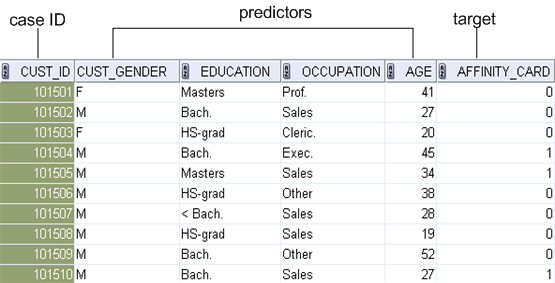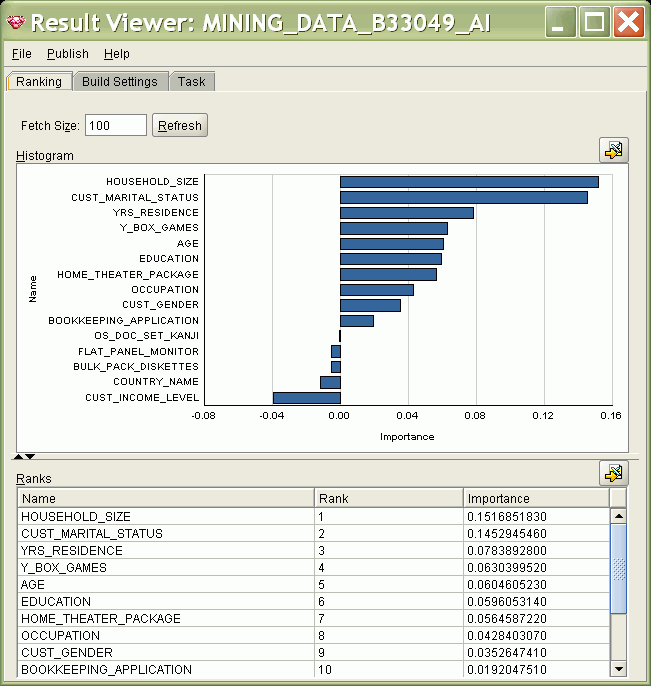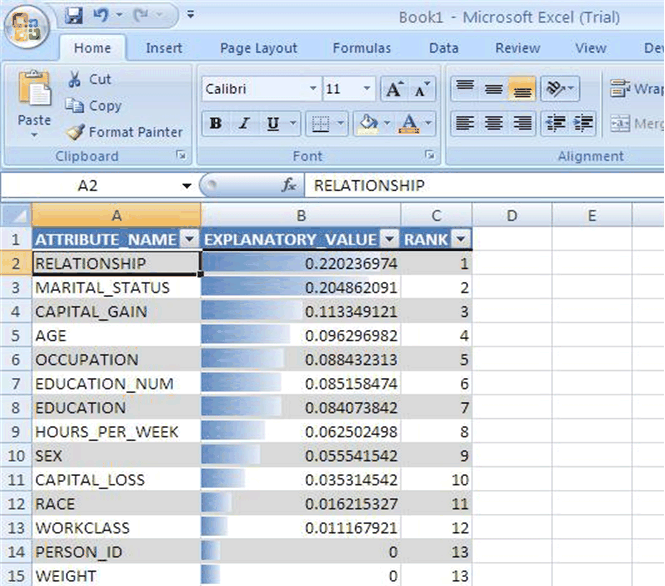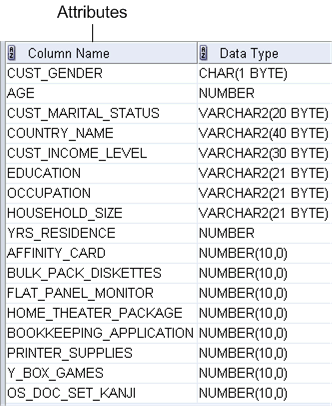| Oracle® Data Mining Concepts 11g Release 2 (11.2) Part Number E12216-03 |
|
|
View PDF |
| Oracle® Data Mining Concepts 11g Release 2 (11.2) Part Number E12216-03 |
|
|
View PDF |
This chapter describes the feature selection and extraction mining functions. Oracle Data Mining supports a supervised form of feature selection and an unsupervised form of feature extraction.
This chapter contains the following sections:
Sometimes too much information can reduce the effectiveness of data mining. Some of the columns of data attributes assembled for building and testing a model may not contribute meaningful information to the model. Some may actually detract from the quality and accuracy of the model.
For example, you might collect a great deal of data about a given population because you want to predict the likelihood of a certain illness within this group. Some of this information, perhaps much of it, will have little or no effect on susceptibility to the illness. Attributes such as the number of cars per household will probably have no effect whatsoever.
Irrelevant attributes simply add noise to the data and affect model accuracy. Noise increases the size of the model and the time and system resources needed for model building and scoring.
Moreover, data sets with many attributes may contain groups of attributes that are correlated. These attributes may actually be measuring the same underlying feature. Their presence together in the build data can skew the logic of the algorithm and affect the accuracy of the model.
Wide data (many attributes) generally presents processing challenges for data mining algorithms. Model attributes are the dimensions of the processing space used by the algorithm. The higher the dimensionality of the processing space, the higher the computation cost involved in algorithmic processing.
To minimize the effects of noise, correlation, and high dimensionality, some form of dimension reduction is sometimes a desirable preprocessing step for data mining. Feature selection and extraction are two approaches to dimension reduction.
Feature selection — Selecting the most relevant attributes
Feature extraction — Combining attributes into a new reduced set of features
Oracle Data Mining supports feature selection in the attribute importance mining function. Attribute importance is a supervised function that ranks attributes according to their significance in predicting a target.
Finding the most significant predictors is the goal of some data mining projects. For example, a model might seek to find the principal characteristics of clients who pose a high credit risk.
Attribute importance is also useful as a preprocessing step in classification modeling, especially for models that use Naive Bayes or Support Vector Machine. The Decision Tree algorithm includes components that rank attributes as part of the model build.
Oracle Data Mining does not support the scoring operation for attribute importance. The results of attribute importance are the attributes of the build data ranked according to their predictive influence. The ranking and the measure of importance can be used for selecting attributes.
Figure 9-1 shows six columns and ten rows from the case table used to build the Oracle Data Mining sample attribute importance model, ai_sh_sample. A target value of 1 has been assigned to customers who increased spending with an affinity card; a value of 0 has been assigned to customers who did not increase spending.
Figure 9-1 Sample Build Data for Attribute Importance

Figure 9-2 shows the results returned by the model ai_sh_sample. The attributes used to build the model are ranked in order of their significance in predicting the target. The results show that household size and marital status have the most effect on whether or not the customer will increase spending with an affinity card. Household size is approximately twice as important as length of residence.
Figure 9-2 Attribute Importance in Oracle Data Miner

Negative ranking indicates noise. Attributes ranked at zero or less do not contribute to the prediction and should probably be removed from the data.
See Also:
Oracle Data Mining Administrator's Guide for information about the Oracle Data Mining sample programsThe predictive analytics EXPLAIN operation also implements attribute importance. Figure 9-3 shows EXPLAIN results in Microsoft Excel, using the Oracle Data Mining Spreadsheet Add-In for Predictive Analytics.
The results show that the attribute RELATIONSHIP is the most important in predicting the target designated for this data set. Attributes that have an importance less than or equal to zero all have the same rank; they are displayed with an explanatory value of zero. Attributes with an explanatory value of zero are noise.
Figure 9-3 EXPLAIN in the Spreadsheet Add-In for Predictive Analytics

See Also:
Chapter 3 for information about Oracle predictive analyticsFeature extraction is an attribute reduction process. Unlike feature selection, which ranks the existing attributes according to their predictive significance, feature extraction actually transforms the attributes. The transformed attributes, or features, are linear combinations of the original attributes.
The feature extraction process results in a much smaller and richer set of attributes. The maximum number of features is controlled by the FEAT_NUM_FEATURES build setting for feature extraction models.
Models built on extracted features may be of higher quality, because the data is described by fewer, more meaningful attributes.
Feature extraction projects a data set with higher dimensionality onto a smaller number of dimensions. As such it is useful for data visualization, since a complex data set can be effectively visualized when it is reduced to two or three dimensions.
Some applications of feature extraction are latent semantic analysis, data compression, data decomposition and projection, and pattern recognition. Feature extraction can also be used to enhance the speed and effectiveness of supervised learning.
Feature extraction can be used to extract the themes of a document collection, where documents are represented by a set of key words and their frequencies. Each theme (feature) is represented by a combination of keywords. The documents in the collection can then be expressed in terms of the discovered themes.
See Also:
Chapter 20, "Text Mining"Figure 9-4 shows the columns in the case table used to build the Oracle Data Mining sample feature extraction model, nmf_sh_sample. The CUST_ID column holds the case identifier. No column is designated as a target for feature extraction since the algorithm is unsupervised.
Figure 9-4 Sample Build Data for Feature Extraction

Figure 9-5 shows information about a feature in Oracle Data Miner. It shows the attribute values with coefficients between .05 and .09 for feature 5 extracted from the build data. A coefficient is a constant multiplicative factor of an attribute. A higher coefficient absolute value indicates a higher influence of the attribute on the feature.
Typically these features would be used as input to another model. For an example, see "Sample Text Mining Problem".
Figure 9-6 shows some of the results when the model is applied to a different set of customer data. Cases are assigned to features with a value that indicates the importance of that feature in that case.
Note:
Oracle Data Miner displays the generalized case ID in theDMR$CASE_ID column of the apply output table.See Also:
Oracle Data Mining Administrator's Guide for information about the Oracle Data Mining sample modelsOracle Data Mining uses the Minimum Description Length (MDL) algorithm for feature selection (attribute importance).
See Also:
Chapter 14, "Minimum Description Length"Oracle Data Mining uses the Non-Negative Matrix Factorization (NMF) algorithm for feature extraction.
See Oracle Data Mining Application Developer's Guide for information about feature extraction for text mining.